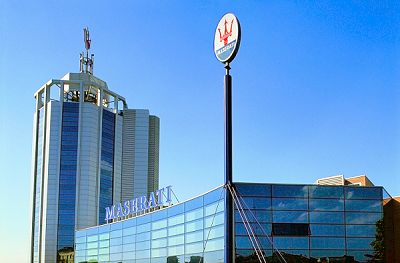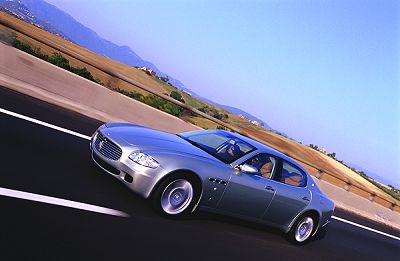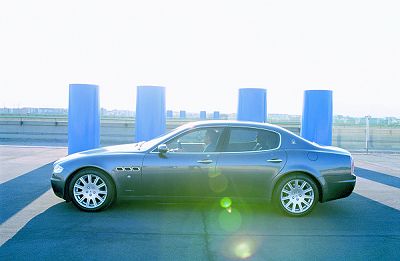|
|
MASERATI QUATTROPORTE |
|
|
 |
|
|
New saloon delivers sporty-drive and sumptuous four-seater comfort
5 metre limousine offers unrivalled luxury, style and elegance
Perfect handling balance with 47%-53% front-rear weight split
400 bhp V8 engine generates massive torque from 2,500 rpm
Maserati DuoSelect six-speed gearbox with automatic and manual modes
Unique Skyhook electronic multi-mode adaptive suspension
Right-hand drive, 170 mph saloon on sale in UK from late spring 2004
Italy is renowned throughout the world for certain qualities: artistic creativity, appreciation of beauty, innovative engineering talent, love of sophisticated luxury, culture and music, a passionate love of life. Maserati's long history in the exclusive luxury executive saloon sector is part of that great culture too. The ingenuity and technology, honed by decades of success on the track, are seamlessly married with sophisticated styling and materials as well as functional yet alluring forms and solutions. The new Maserati Quattroporte continues that cultural odyssey and will write a fresh and entirely Italian chapter in the history of unique cars.
THE CONCEPT
Inspired by the building of the new motorways in the late 1950s, Maserati unveiled the first ever Quattroporte model in 1963. This unique car combined all of the luxury of a sophisticated, exclusive executive saloon with the performance of a clearly sports-inspired chassis and an engine borrowed from the world's most powerful barchetta, the 450 S.
The majestic new Pininfarina-designed Maserati Quattroporte now takes that same concept and gives it a contemporary twist to suit the needs of today's drivers. This luxury saloon is the perfect continuation of the superb Maserati flagship tradition that ranged from the unveiling of the first Frua-bodied Quattroporte to the 1976 Giugiaro model - the car of choice for Italian President Sandro Pertini. The Quattroportes were spacious comfortable limousines that effortlessly and safely ate up the miles on long journeys whilst still delivering the blistering performance of a thoroughbred, racer-bred sportscar, whenever required.
The new Quattroporte makes its debut into a very different world, but it is every bit as audacious and exclusive as its predecessors in terms of its concept. This completely innovative newcomer brings an exciting breath of fresh air to the large luxury saloon market segment. That breath of fresh air comes from the fact that the curvaceous yet aggressive-looking, 5 metre long Quattroporte marks the rebirth of the Italian flagship car, the ultimate embodiment of qualities for which Italy is renowned throughout the world. |
|
|
 |
|
|
STYLING AND DESIGN
The new Quattroporte is the first Maserati that Pininfarina has designed in 50 years. The late great Pinin himself created some extraordinary sportscars for the Trident marque in the late 1940s and early 1950s, the last of which was the 1953 A6GCS Berlinetta Sport. From 1955, the Turin-based coach builder devoted itself to Ferrari, then the Trident's fiercest rival. Nonetheless, it was thanks to that ancient history and Pininfarina's long-held ambition to one day design a big high performance Italian saloon, that we now have the new Maserati Quattroporte - a car that combines strength and power in a stunningly sensual package, in which every last detail has been carefully finished and the Trident's trademark styling cues highlight its legendary heritage.
The Quattroporte was designed over a long wheelbase with a stance that highlights the length of the bonnet. The bonnet, combined with the imposing grille and distinctive C-pillar, are all part of the Trident tradition - three styling cues that mark the Quattroporte as a real Maserati at first glance and serve to accentuate its authoritative personality. The legendary Trident badge takes pride of place on the nose, framed by the chromed grille. Three air intakes lighten the look of the lower part of the front bumper, while the headlights are set slightly back from the grille and delineate the top of the car's nose.
The side profile is truly dynamic, thanks to the very short front overhang and the low front wing line, while the rear wheels are set in a muscular volume beneath the triangular C-pillar that frames the famous Maserati trident and arrow symbol, as previously featured on the Quattroporte Frua and the Mistral. Appropriately, the inimitable Pininfarina signature adds an extra flourish to each flank.
The clean sweep of the sides, is offset by three small rectangular air vents (a clear reference to the A6 1500 Berlinetta Speciale), and accentuated by the ample greenhouse area. The uninterrupted expanse of glass is enhanced by the absence of a quarterlight on the front doors, a glazing solution often associated with GT cars.
The rear door when opened, continues to sinuously and harmoniously follow the line of the bodywork: a particularly attractive design detail. This soft, clean overall look is picked up again in the Quattroporte's rear section which is high and compact and seems to be actively pushing the car forward. A slender lip has been incorporated into the tail to aid airflow and generate downforce. Just like the aerodynamic line, it is the result of long hours in the wind tunnel aimed at optimising the car's aerodynamic efficiency (Cd 0.35) to guarantee improved performance, safety and stability without having to sacrifice any of its alluring styling.
The two elegant rear light clusters, with their chrome-framed reflectors, give the tail a sophisticated flourish. The bold diagonals between the red glass, clear glass and metal bodywork, echo the shape of the classic Maserati Trident. Both sets of twin exhausts are oval in cross-section.
STRUCTURE, REFINEMENT AND PRODUCTION
The Quattroporte boasts an all-new platform, specifically designed to optimise the in-house engineering talents of the marque that is synonymous with performance and cutting edge technology. The Quattroporte's architecture is typical of a luxury flagship model - a 'three-box', four-door design, with longitudinally-mounted front engine driving the rear wheels. It has an unusually long (3064 mm) wheelbase for superlative ride comfort and an ideal weight distribution to achieve perfectly balanced, responsive handling.
Weight distribution is 47% front and 53% rear - an extraordinary result in the traditional large executive saloon segment. This set-up maximises traction and gives the car exceptional stability and dynamic balance. This distribution is achieved by setting the engine behind the front axle, and by moving the gearbox to the rear and mounting it in unit with the differential. This layout is normally reserved for high performance sportscars and the Quattroporte is its first application to a luxury saloon.
The bodyshell has excellent torsional rigidity (3200 kgm/degree) and flexural rigidity (1300 kg/mm) which provides a firm foundation for the precise location and operation of the suspension - which is enormously beneficial to the car's handling dynamics - and facilitates significant reductions in the transmission of vibrations.
The Quattroporte is manufactured in the world's most advanced small series production facility, in Modena. The Ferrari Maserati Group has invested heavily in Maserati to guarantee that it delivers the quality cars to match the highest production standards in the automotive world. The Maserati factory combines avant-garde electronic engineering control systems with the traditional experience of a skilled workforce schooled in the culture of Italian craftsmanship.
A brand-new dedicated Quattroporte production line has been added to the two existing lines for the Coupe and Spyder. That dedicated line is divided into two areas: one for engineering and electronic components, and one for interiors and finishes. Specially trained teams work at quality control positions where every element of the car is checked. Assembly of each car must be 'approved' at various intermediate stages, before it can move down the line, and this approach is part of the Maserati philosophy which inspires incredible concentration by its employees.
Every Quattroporte undergoes electronic checking of its engine, transmission, suspension and chassis set-up. After passing the water seal tests, cars are driven on the rolling-road to measure various systems, including the ABS. Once this electronic and human scrutiny is successfully passed, every car is put through a 100 km road test by a highly experienced expert test driver.
Following the road test, a final examination is conducted in the finishing department. With the new Quattroporte, Maserati is taking on one of the most difficult and highly competitive sectors of the world market and the achievement of overall excellence is a point of honour for the marque. |
|
|
 |
|
|
LUXURY, COMFORT AND CONVENIENCE
The design of the Quattroporte's interior is the perfect extension of the exterior styling, its luxurious functionality encompassing the Quattroporte's twin souls. The cabin is warm and bright, its clear-cut forms beautifully crafted out of luxury woods and leathers. The interior is over 2 metres in length, allowing its occupants generous space in which to stretch out and enjoy the journey.
The Quattroporte comes with electronically adjustable seats both front and rear. The front seats have 14 different settings as standard, while the driver's seat also has three memory settings and a special feature that slides the seat back and raises the steering column to make entry and exit even more convenient. The two electric rear seats are independently adjustable for reach over a 10 cm range, and for tilt. The passenger occupying the rear passenger-side seat can also move the front passenger seat forward (by up to 22 cm) using a button on the rear central armrest.
The sportier side of the Quattroporte's dual soul shows in the design of the facia, and the simple, ergonomically optimised layout of the blue & white instruments which are clustered under a single cowling behind the steering wheel, while the major controls are very easy to locate and use. Throughout the design of the facia and centre console, a policy was adopted that each control should be easy to operate and should control a single function.
The comfort and convenience controls are housed in a wood-trimmed, centre console layout, divided into four horizontal bands. The topmost band holds twin air-vents and an oval analogue clock. The second band is for the Multi Media System, incorporating the satellite navigation display. The bottom band operates the automatic climate control and clear display for the separate front and rear zones.
The drive and chassis controls - for the transmission, suspension, and stability programme - are located in a separate, handy, driver-dedicated area on the transmission tunnel.
The Quattroporte's interior provides the occupants with a sense of tranquillity and security. Even in standard form, Quattroporte has the feel of a bespoke car in which luxury woods and natural materials create an atmosphere of noble elegance. Customers can take the bespoke concept several stages further, either by selecting from the options list or by using the dedicated personalisation programme - Officine Alfieri Maserati.
Wood, always a classic feature, is used innovatively in Quattroporte to create large surfaces dotted with small decorative strips of inlay. The central console creates a virtual cascade of luxurious wood, surmounted by the classic oval Maserati clock which is dark blue, just like the dials on the rev counter and speedometer.
Three different woods are available for the Quattroporte: rosewood, mahogany and briarwood, with rosewood offering the richest, clearest finish. The grain - vertical on the central console, horizontal on the door panels - is reminiscent of the kind of splendid craftsmanship normally found aboard luxury yachts. The mahogany has a special vein and the different directions of the grain on the two sides of the cabin are reminiscent of the very best of antique woodworking. The classic walnut root is a symbol of tradition. For drivers who like a more modern ambience, a titanium-style finish is available for some of the interior details.
Another expression of Italian craftsmanship at its best, is the quality of the Poltrona Frau leather upholstery, a standard feature for the Quattroporte. Hand-picked and traditionally worked, this leather has beautiful, kid-glove softness which is matched by its durability and practicality. The cavernous, rectangular 450 litre boot is elegantly finished and is large enough to stow five large Quattroporte bags - made from the same leather as the seat upholstery and available as an option.
ENGINE
The Quattroporte is powered by a compact, lightweight, normally aspirated, 4244cc, 90 degree
V8 engine. Based on the Maserati power unit fitted in the Coupe and Spyder, the all-aluminium engine is modified for its new role in a luxury saloon to produce a maximum of 400 bhp and 75% of maximum torque from just 2,500 rpm. The modifications, primarily to boost torque at lower revolutions, include a new air-filter, new camshaft profiles, a new exhaust system and revised engine mapping.
Weighing just 183 kg, the engine is fitted with a dry-sump lubrication system - a sports-derived solution which allows it to be mounted lower in the car and in turn, lowers the car's centre of gravity for improved stability and handling balance.
Chain-driven twin overhead camshafts per cylinder bank operate four valves per cylinder with hydraulic tappets. The intake cams feature continuously variable phase timing, and valve actuation takes less than 0.15 seconds. The integrated ignition and injection systems are by Bosch and allow the detection of operating malfunctions within the engine control system, to help ensure compliance with emissions limits. The engine control unit (ECU) interfaces with the other systems courtesy of the CAN (Controlled Area Network) to optimise engine control.
Controlled by an electronic drive-by-wire accelerator, the V8 has been developed to ensure the smoothest delivery of power and torque, in a linear fashion, consistently throughout the rev-range. Combined with the dual-mode MDS (Maserati DuoSelect) transmission, the V8 offers maximum driving pleasure, with extraordinary performance parameters. |
|

